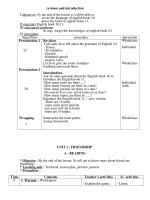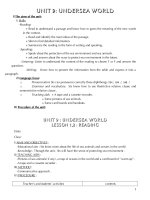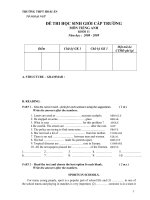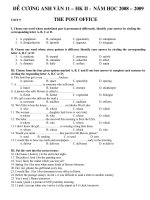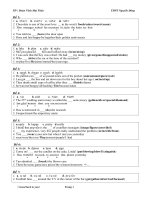anh van 11
Bạn đang xem bản rút gọn của tài liệu. Xem và tải ngay bản đầy đủ của tài liệu tại đây (192.14 KB, 37 trang )
UNIT 9: UNDERSEA WORLD
I)The aims of the unit:
1) Skills:
-Reading:
+ Read to understand a passage and know how to guess the meaning of the new words
in the context.
+ Read and identify the main ideas of the passage.
+ Skim to find detailed information.
+ Summarize the reading in the form of writing and speaking.
-Speaking:
+ Speak about the protection of the sea environment and sea animals.
+ ask and answer about the ways to protect sea environment in the future.
-Listening: Listen to understand the content of the reading to choose T or F and answer the
questions.
-Writing: Know how to present the information from the table and express it into a
paragraph.
2) Language focus:
o Pronunciation: Sts can pronounce correctly three diphthongs /i /, /e /, /u / ə ə ə
o Grammar and vocabulary: Sts know how to use Restrictive relative clause and
nonrestrictive relative clause .
o Teaching aids: + A tape and a cassette recorder.
+ Some pictures of sea animals.
+ Some card boards and handouts.
II) Procedure of the unit:
UNIT 9 : UNDERSEA WORLD
LESSON 1,2 : READING
Date:
Class:
I) AIMS AND OBJECTIVES :
-Educational aim : Sts know more about the life of sea animals and oceans in the world
-Knowledge : Through the unit , Sts will have the sense of protecting sea environment .
II) TEACHING AIDS :
-Pictures of sea animals( if any) ,a map of oceans in the world and a card board of ‘‘warm up’’.
-A tape and a cassette recorder .
III) METHOD :
-Communicative approach .
IV) PROCEDURE :
Teacher’s and students’ activities contents
1
WARM –UP: (5ms)
-Sts close their books .
-T asks the Ss to think out some sea animals and
write them in the card board ( Suggested answers:
humpback whale, sea turtle, tar fish, sea horse,shark,
dolphin, whale, crab, seal, salmon, jellyfish, …)
-T introduces new lesson: To understand more clearly
about sea animals and their environment, today we’re
going to study lesson 1: Reading
BEFORE YOU READ: (8ms)
- Ssts work in pairs to match the pictures with the
names ssome sea creatures.
-
- : sts work in groups to discuss which of them are in
ddanger and need to be protected now.
- T go round to help .
-T correct the information in front of the class.
WHILE YOU READ:
- Ss open their books and read in silent by following
the cassette recorder once to practise new words.
Task a: (12ms)
- Ss read in individual for three minutes.
- T remind Ss of finding 8 words from the reading.
- Ss tell the parts of speech of these words.
- Ss skim to find out necessary information.
- Ss interchange in pairs.
-T goes round to check.
Task b: (10ms)
-Ss read the questions.
- Ss read in individual and find out information
-
- . Answer keys:
- . . 1g,6a
. 2f,7d
. 3c,8b
. 4e
.5h
. Answer keys:
whale and sea turtles need to be
protected.
Vocabulary :
-blooded mammal (n)
- rescue –v
- stressful-adj
- spirit-n
. Answer keys:
1. t
2. f
3. t
4. f
5. f
6. f
.
Answer keys:
2
Sea
animals
from the passage.
-Ss interchange in pairs.
-T corrects them before the class.
Task c:
Ss interchange in pairs.
AFTER YOU READ: (10ms)
- Sts work in pairs to skim over the reading.
-T suggests and asks Sts to do what he tells.
- T corrects them before the class.
-
1.. They helped …
2. its purpose is to help people with …
3. after the progrtam,
4. dolphins can get
5. Because if ..
. Answer keys:
1. mammals
2. take the easy way out
3. disturb
4. contact-n
5. bite the hand that feed
6. caution
HOMEWORK: (2ms) - Read the passage again ,learn by heart new words.
- Prepare “Listening”
---------------------------------------------------------------------------------------------------------------------------------
UNIT 9 : UNDERSEA WORLD
LESSON 3 : LISTENING
Date:
Class:
I) AIMS AND OBJECTIVES :
-Educational aim:. Through the unit , Sts will have the sense of protecting sea animals.
-Knowledge:
+ General knowledge: Ss will listen to the song about a whale
+ Language: Ask and answer WH- questions, choose T or F.
II) TEACHING AIDS : a tape, a cassette player and a card board of “Warm-up”.
III) METHOD : Listening -Communicative approach .
IV) PROCEDURE :
Teacher’s and students’ activities contents
3
WARM –UP: (5ms)
What can you see in the picture?
What is the man doing?
BEFORE YOU LISTEN: (10ms)
-Ss practice in pairs,asking and answering these
two questions:
1. Do you think whales are fish? Why(not)?
2. Why do people keep hunting whales?
- T lets Ss read the words ( will appear) in the tape
script, pay attention to the way of pronunciation
and the meanings (if any).
- Ss read these words in silent.
-T corrects them before the class.
WHILE YOU LISTEN:
Taskb: (10ms)
- T asks Ss to read the song given
- - T explains the sentences that Ss don’t
understand.
- T turns on the cassette player twice.
- Ss work in individual, listen and fill in the
blanks
AFTER YOU LISTEN:
Task3: (10ms)
-Ss work in groups : ask and answerthe questions:
Activity 1:
Suggested answers:
1.Whales are not fish because they raise
their young on milk.
2. Because they want to catch whales for
food, oil, leather and other products.
Activity 2: Listen and repeat
-Moonlight –n
- passionate wail-n
- reef –v
- squeak-n
.
Answer keys:
1.spring
2.recorder
3.singing
4.heart
5. harpoons
ê 6. death
7. feel
8. save
Suggested answers:
HOMEWORK: (2ms) - Learn by heart new words, rewrite some whales’ special features.
- Prepare “ Writing”.
--------------------------------------------------------------------------------------------------
4
UNIT 9 : UNDERSEA WORLD
LESSON 4 : SPEAKING
PERIOD :
Date:
Class:
I) AIMS:
-Educational aim : asking for and giving reasons or explanations
-Knowledge:+ General knowledge: Ss will get some ways to protect our sea environment.
+ Language: Sentences and expressions for asking for and giving reasons or
explanations
II) TEACHING AIDS : a card board of task 2.
III) METHOD : Communicative approach .
IV) PROCEDURE :
Teacher’s and students’ activities contents
WARM –UP: (5ms)
Sing a song
PRE-SPEAKING: (8ms)
Sts work in pairs ask and answer
T explains expressions
WHILE SPEAKING:
Taska: (10ms)
Sts work in pairs , find the reason to explain why
Task b: (10ms)
Sts work with a partner and talk about these
activities.
POST-SPEAKING:
Taskc: (10ms)
-Ss work in groups and describe what is happening
in each picture.
Suggested answers:
Why ?
How come..?
-Because..
Vocabulary:
- S -moonlight
-switch on
-
- Ex: Do you like..
Why
Because…
Suggested keys:
Ex:
A: A crab
/
s getting out of its old shell.
Why?
B:
/
cos the old one is too small for it.
5
HOMEWORK: (2ms) -Learn by heart new words, structures and expressions.
- Make 5 sentences about the protecting of the sea, using the structure
“We should/ shouldn’t…”
- Prepare “Writing”.
---------------------------------------------------------------------------------------------------------------------------------
UNIT 9 : UNDERSEA WORLD
LESSON 5,6 : WRITING
PERIOD :
Date:
Class:
I) AIMS :
-Educational aim: Ss will have the love of sea animals.
-Knowledge:
+ General knowledge: Through the unit , Ss will know about the sperm whales and their special
features.
+ Language: Ss know how to interpret the information from the table into a paragraph.
II) TEACHING AIDS : a card board of “Warm-up”, a picture of a dolphin.
III) METHOD : Communicative approach .
IV) PROCEDURE :
Teacher’s and students’ activities contents
WARM –UP: (5ms)
-Sts close their books .
-T asks the Ss to play jumbled words:
PRMES, EAHLWS, REA, THE, IGSTEGB,
NMLSAIA, NO, ERHTA, HTAT, HVEA,ETHET.
-T introduces new lesson: Today we’re going to study
invitation letters
BEFORE YOU WRITE: (8ms)
Task a:
Activity 1:
Suggested answers:
Sperm whales are the biggest animals
on earth that have teeth.
Vocabulary:
6
- T explains the new words and expressions.
- Ss open their books and read in silent the letters.
Then complete the table
WHILE YOU WRITE:
Task b: (10ms)
- Ss work in groups to combine the fragments
below to form two letters of invitation
-T corrects these information before class.
- T explains the style, vo, stru…
task c.
- T reminds Ss of referring to the description in task
c
- Ss Practice in groups to choose one topic then write
a letter of invitation
- T goes round to help them or gives the meanings
of new words. (if any )
POST-SPEAKING:
-T asks one S of each group to report to the class
what his group has discussed.
-T corrects these reports before class.
Suggested answers:
-going to Tri nguyen aquarium
-Ann and John are passing through
-to welcome back Pro. Ali
-How obout going to the movies
tonight?
-Can you come to dinner on Sunday?
….
Letter 1( informal)
Letter 2(formal)
Suggested answers:
.
HOMEWORK: (2ms) -Learn by heart new words and expressions.
o Write a letter of invitation
o Prepare “ Language focus”.
---------------------------------------------------------------------------------------------------------------------------------
UNIT 9 : UNDERSEA WORLD
LESSON 7 : LANGUAGE FOCUS
PERIOD :
Date:
Class:
I) AIMS:
7
-. Word study: compound adj
Grammar and vocabulary: Sts know how to use relative clauses
II) TEACHING AIDS : a tape, a cassette player
III) PROCEDURE :
Teacher’s and students’ activities contents
WARM –UP: (5ms)
Word study: (8ms)
Activity 1: word study
T explain how to form a Compound
adjectives, give example
Sts do the exercises
GRAMMAR AND VOCABULARY:
a. Restrictive Relative clauses:
- Ss read the example carefully.
- T explains the restrictive relative clauses
-Ss practice in pairs.
- T walks round to help
(Exercise a- Page 124)
b. Nonrestrictive Relative clauses:
- Ss read the example carefully.
- T explains the nonrestrictive relative clauses
-Ss practice in pairs.
- T walks round to help
(Exercise a- Page 125)
C. The passive voice (revision)
Ss read the example carefully.
- T explains the passive voice
-Ss practice in pairs.
- T walks round to help
Suggested answers:
Compound adjectives
Noun + verb(pp)= Compound adjectives
Ex: The date (which) I have in mind is June
20
Ex: While swimming with wild dolphins, we
are disturbing these animals, which may get
angry and bite the hand that feeds them.
Ex: Dolphins are considered people
/
s friends.
HOMEWORK: (2ms) -Learn by heart new structures.
- Prepare “ Reading”- unit 10
-
---------------------------------------------------------------------------------------------------------------------------------
8
---------------------------------------------------------------------------------------------------------------------------------
UNIT 10: CONSERVATION
Date:
Class:
I)Aims and objectives:
Ss will have knowledge of preserving and safeguarding natural environment, they will know the
causes that bring about environmental disasters and have the sense of conserving our natural
environment.
Vocabulary :Words dealing with conservation
o Grammar: Sts know how to use the modal verb (should).
o Teaching aids: + A tape and a cassette recorder.
+ Some pictures of some forests and forest fires.
+ Some card boards and handouts.
II) Procedure of the unit:
UNIT 10 : CONSERVATION
LESSON 1,2 : REAding
PeRIOD :
Date:
Class:
I) AIMS AND OBJECTIVES :
-Educational aim : Ss should contribute their parts to the protection of the natural environment.
-Knowledge:+ General knowledge: Ss learn about the functions of ecotourism and about the
safeguarding of natural environment.
+ Language: Sentences and expressions for making suggestions to protect natural
environment.
II) TEACHING AIDS :
-Pictures of zoos or forests ( if any) , a card board of ‘‘warm up’’, some handouts.
- Tapes and a cassette player.
III) METHOD :Communicative approach .
IV) PROCEDURE :
Teacher’s and students’ activities contents
WARM –UP: (5ms)
-Sts close their books .
-T asks the Ss to think out some environmental
problems and write them in the card board.
-T introduces new lesson by asking questions:
What is conservation?
Conservation is the protection of natural things,
such as plants and animals.
9
Environmenta
l
problems
BEFORE YOU READ: (8ms)
Activity 1:
- Ss work in pairs to look at the picture in page
126 and match the solutions with the pictures
- T goes round to help .
-T correct the information in front of class.
WHILE YOU READ:
Task a: (12ms)
- Ss open their books and read in silent by
following the cassette recorder once to practice
new words.
-Ss scan quickly the reading to find out the new
words
- T goes round to help Ss to guess the meanings
of the new words in the context.
Sts match the headings with the appropriate
paras
Task b:
- Ss read the text in silence and do the task b.
-ss match the words or phrase in column A
with B
- Ss interchange in pairs.
-T goes round to check.
- T corrects the information before class.
Task c:
-Ss work in groups : ask and answer
-
Suggested answers:
-the extinction of the plants and animals
- pollution, floods, droughts, volcanic eruption
,earth quakes, forest fire,…
a.3
b.1
c.2
Vocabulary :
-conserve(v)
-ecosystem(n)
-ecotourism(n)
-fauna(n)
- flora-n
Answer keys of task a:
1C; 2D; 3A; 4B
Answer keys of task 2:
1.c; 2.e; 3.a; 4.d; 5.b
.
Answer keys of task c:
1.Because of its nature beauty…
2. Flora species and fauna speces
3. to promote the economy and provide
more..
4. He implies that …
10
AFTER YOU READ: (10ms)
- Sts work in groups to find the answers in the
reading to prove the importance of
conservation
- T goes round to check.
- T corrects them before the class.
HOMEWORK: (2ms) - Read the passage again ,learn by heart new words.
- Prepare “Speaking”
---------------------------------------------------------------------------------------------------------------------------------
UNIT 10 : CONSERVATION
LESSON3 : LISTENING
PERIOD :
Date:
Class:
I) AIMS: Ss can list the events they’ve heard, understand the causes that bring about forest fires
and have the sense of protecting forests.
II) TEACHING AIDS : a tape, a cassette player and pictures of forest fires for “Warm-up”.
III) METHOD :
IV) PROCEDURE :
Teacher’s and students’ activities contents
WARM –UP: (5ms)
-Ss close their books .
-T shows the pictures of forest fires and asks Ss:
1. What do you see in the pictures ?
2.Have you ever seen a forest destroyed by fire?
-T introduces new lesson: Today we’re going to listen
activities that cause harm to the natural environment.
BEFORE YOU LISTEN: (10ms)
-Ss practice in pairs, talking about activities that
cause harm to the natural environment.
-T goes round to help them or gives the meanings of
new words. (if any )
Suggested answers:
1.We can see forest fires.
2.Yes, I have./ No, I haven’t.
Suggested answers:
A forest fire may be caused by a cigarette
end, a campfire, lightening, drought,…
Activity 2: Listen and repeat
Vocabulary:
11
-T lets Ss read the words ( will appear) in the tape
script, pay attention to the way of pronunciation and
the meanings (if any).
- Ss read these words in silent.
-T corrects them before the class.
WHILE YOU LISTEN:
Task b: (10ms)
- T asks Ss to read the sentences given and
underline the important words.
- T explains the sentences that Ss don’t understand.
- T turns on the cassette player twice.
-Ss fill in the blanks
- - T asks Ss to interchange the information they’ve
heard with his/ her partner and corrects them.
AFTER YOU LISTEN:
Ss works in groups to write a list of what you
should not do as ecotourists. Give reasons.
- natural habitat
- ecotour
. Answer keys of task a
1.
2.damaging young trees
3. building campfires
4. causing damge to forests
Suggested answers of task 2:
1. national park
2. wild life
3. feed, tease
4. lifestyles
5. fauna and flora
6. educational
7. chopping, fish
8. conservation, preservation
HOMEWORK: (2ms) - Learn by heart new words, rewrite what they remember about the
passage they’ve listened to.
- Prepare “ Speaking”.
UNIT 10 : CONSERVATION
LESSON 4 : SPEAKING
PERIOD :
Date:
Class:
I) AIMS: making suggestions about nature conservation.
II) TEACHING AIDS :
-pictures
III) METHOD : Communicative approach .
12
IV) PROCEDURE :
HOMEWORK: (2ms -Learn by heart new words and structures.
- think of a camping trip and make a list of some things tourists should and
should not do.
- Prepare “Writing”.
---------------------------------------------------------------------------------------------------------------------------------
---------------------------------------------------------------------------------------------------------------------------------
UNIT 10 : CONSERVATION
LESSON 5,6: WRITING
Teacher’s and students’ activities contents
WARM –UP: (5ms)
Sing a song
PRE-SPEAKING: (8ms)
- T explains the new words, structures and
expressions for Ss to interchange in pairs.
-Ss study them by learning their meanings and
repeating after T.
WHILE SPEAKING:
b. ss work in pairs, to make up exchanges
about environmental and their solutions.
- T goes round to help and check.
POST-SPEAKING:
Task4: (10ms)
-Ss work in groups to think of a camping trip
and make a list of some things tourists should
and should not do.
-T asks one S of each group to report to the
class what his group has discussed.
-T corrects these reports before class.
Answer keys:
2. I think it is. We should conserve nature, i.e.
control the cutting down of trees and keep the
river clean.
3. Maybe because the do not know the
importance of conservation.
…
Ex:
A: Have you ever thought of reducing
deforestation?
B: I think we should control the cutting down
of trees.
13
PERIOD :
Date:
Class:
I) AIMS :
-Ss understand the content and the language used in
- Ss can write a friendly letter of acceptance or refusal, based on the given situations.
II) TEACHING AIDS :
III) METHOD : Communicative approach .
IV) PROCEDURE :
Teacher’s and students’ activities contents
WARM –UP: (5ms)
Play a game
BEFORE YOU WRITE: (8ms)
a:
- T explains the new words and expressions.
- Ss open their books and read in silent the
letter and underline the language used to
express acceptance and refusal
WHILE YOU WRITE:
T explains language in writing letter.
POST-SPEAKING:
b
-T asks Ss to read task b carefully before
writing and try to write a meaningful invitation
letter.
- T goes round to help them or gives the
meanings of new words. (if any )
-T directs Ss’ attention to the tense and some
adv of time (since, now, soon).
-Ss work in groups.
-T may ask one of the to read his letter aloud
Suggested answers:
- thank you very much for your
invitation
-I
/
d be very happy to come
-Thank you…
-I
/
m sorry…
page 133
Page 133
14
